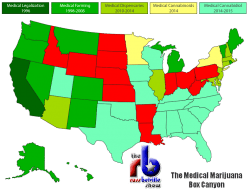
Yesterday, the governor of Texas signed another one of those limited cannabidiol oil bills. It’s the fifteenth state to have such a law, and this one gets even more restrictive than its predecessors. The CBD oil will only be available to epileptics, only after they have tried at least two other conventional treatments unsuccessfully and only if two doctors agree CBD oil should be recommended.
These non-whole-plant states represent the proof of a theory I have promulgated since 2010 known as the Medical Marijuana Box Canyon. The hypothesis is that if you fight for only for medical marijuana, your marijuana is going to become medical only.
| Medical Permission Legalization States – 1996 (1) | California |
| Medical Marijuana Farming States – 1998-2008 (12) | Alaska, Colorado, Hawaii, Maine, Michigan, Montana, Nevada, New Mexico, Oregon, Rhode Island, Vermont, Washington |
| Medical Marijuana Dispensary States – 2010-2014 (9) | Arizona, Connecticut, DC, Delaware, Illinois, Maryland, Massachusetts, New Hampshire, New Jersey |
| Medical Cannabinoid States – 2014 (2) | New York, Minnesota |
| Medical Cannabidiol States – 2014-2015 (15) | Alabama, Florida, Georgia, Iowa, Kentucky, Mississippi, Missouri, North Carolina, Oklahoma, South Carolina, Tennessee, Texas, Utah, Virginia, Wisconsin |
The Box Canyon is a metaphor from old western movies, where the cowboys are riding hard to get away, but get driven into an ambush where canyon walls prevent escape on three sides while the bad guys attack from the fourth. With respect to marijuana, it’s the idea that our framing of marijuana as medicine, while successful in helping us escape total prohibition, has boxed us into a political trap that retards the decline of marijuana prohibition.
First, let’s look at the evolution of medical marijuana. We begin in California in 1996, which passed Prop 215, the most wide-open medical marijuana law in the nation. The ease with which someone can get a medical marijuana recommendation there really makes their system more of a “legalization with doctor’s permission” law, notwithstanding the localities that ban medical cultivation.
But inherent in that idea of a doctor’s recommendation is tacit support for the idea that marijuana use is bad unless one has a valid excuse. It’s the “We’re Patients, Not Criminals” frame. It transformed the frame of the prohibition of marijuana from “a dangerous substance no one shall use” to “a medicine stoners abuse to get high,” thereby shifting the evil from the plant itself to the person who’s using it.
So, in order to prevent the evil medicine-abusing stoners from gaming the medical marijuana system to avoid prosecution, the next set of laws added strict condition lists and patient registries. Plant and possession limits got lower and lower. Throughout the late 1990s and the 2000s, we got a dozen of what I call “medical marijuana farming states” where patients can grow their own cannabis for medical use.
Then in 2010, Arizona passes the first medical marijuana law to limit who can grow their own cannabis. If one is within 25 miles of a dispensary (as 97.2% of Arizonans now are), one cannot grow cannabis, one must purchase it at the dispensary. Massachusetts followed with only those who can prove “hardship” being allowed to grow. Successive states didn’t allow anyone to home grow; all must purchase from dispensaries. Now there are nine of these “medical marijuana dispensary states”, where marijuana is treated just like any other medicine you must buy at the pharmacy.
Last year, we saw medical marijuana transformed into something you’re not allowed to have in its raw plant form, as New York and Minnesota became the first “medical cannabinoid states”. Then after Dr. Gupta’s popular “Weed” documentary showed epileptic kids healed by cannabidiol, Utah kicked off the CBD-only craze that yesterday added to the “medical cannabidiol states”. Boosting the support for CBD-only in these states is that it doesn’t get one high, which, of course, is something only those medicine-abusing stoners would want.
So for 2016 and beyond, what happens with medical marijuana? We can expect more of the conservative Midwest and Southern states to pass some form of CBD-only law. Florida will likely pass either a medical cannabinoid or medical marijuana dispensary amendment. But I believe the prospects of another state passing a medical marijuana farming law are slim to none. Marijuana has indeed become medical and soon, as further clinical trials on cannabinoid medicines are passed, it will become pharmaceutical.
When that happens, expect to see Big Pharma’s cannabinoid preparations replacing crude flowers and extracts on the shelves in medical cannabidiol, medical cannabinoid, and medical marijuana dispensary states. After all, we asked for them to treat cannabis like medicine. When was the last time you found any willow bark in the aspirin section?
(Coming up in Part Two, how medical marijuana screwed itself in the Pacific Northwest and how Ohio 2015 legalization may be the breakthrough for medical marijuana farming.)






